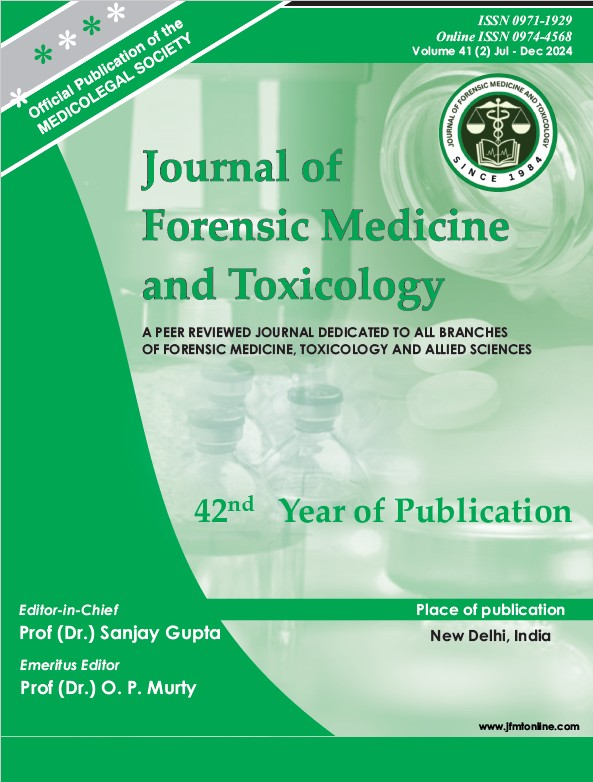Behind the flames: a retrospective study of burn injury cases in a tertiary care centre, Nizamabad
DOI:
https://doi.org/10.48165/jfmt.2025.42.3.11Keywords:
Burn Injury, socioeconomic circumstances, Gender differences, total body surface areaAbstract
Background: Burns are a global public health problem, accounting for an estimated 180,000 deaths annually.1 The majority of these occur in low- and middle-income countries and almost two thirds occur in the WHO African and South-East Asia Regions. Non-fatal burns are a leading cause of morbidity, including prolonged hospitalization, disfigurement and disability, often with resulting stigma and rejection. According to the Na tional Burns Programme, 91,000 of these deaths are women; a figure higher than that for maternal mortality. Women of child bearing age are on average three times more likely than men to die of burn injuries. Females have slightly higher rates of death from burns compared to males. This contrasts with the usual injury pat tern, where rates of injury for the various injury mechanisms tend to be higher in males than females.2 Along with adult women, children are particularly vulnerable to burns. Burns are the fifth most common cause of non-fatal childhood injuries.3 Methods: Retrospective study involving 53 cases of burn injuries were included in this study over a period of 3 years. Results: Out of 53 cases, 37 individuals were females depicting female preponderance.
Downloads
References
Saukko P, Knight B. Fatal pressure on the neck. In: Knight’s Forensic Pathology. 3rd ed. London: Arnold Publication; 2004. p. 311.
National Burns Repository. According to the National Burns Repository, India has the highest number of burn deaths [Internet]. PubMed; 2016 [cited 2025 Sep 19]. Available from: https://pubmed.ncbi.nlm.nih.gov/27578343/
World Health Organization. Burns [Internet]. WHO Fact Sheets; 2018 [cited 2025 Sep 19]. Available from: https://www.who.int/news-room/fact-sheets/detail/burns#:~:text=An%20estimated%20180%20000%20deaths,in%20the%20home%20and%20workplace
World Health Organization. Burns [Internet]. Geneva: WHO; 2021 [cited 2025 Sep 19]. Available from: https://www.who.int/news-room/fact-sheets/detail/burns
National Health Portal of India. Burns [Internet]. New Delhi: Ministry of Health and Family Welfare; 2021 [cited 2025 Sep 19]. Available from: https://www.nhp.gov.in/disease/skin/burns
Moses S, Verma SS, Mathur R. An epidemiological study of burn cases from a single referral hospital in Indore, central part of India and a proposal for burn prevention and care program. Indian J Surg. 2021;83(1):69–77.
Major burns: Part 1. Epidemiology, pathophysiology and initial management. J Emerg Trauma Shock. 2021;22(3):94–103.
Lal S, Yadav GK, Gupta R, Shrivastava GP, Singh S, Bain J. Mortality pattern of burn patients admitted in S. G. M. Hospital Rewa: A teaching institute of central India. J Sci Soc. 2012;39(3):130–5.
Sharma R, Dogra BB, Singh D, Sharma V, Sharma R. A clinico-epidemiologic study of 892 patients with burn injuries at a tertiary care hospital in Punjab, India. J Punjab Acad Forensic Med Toxicol. 2011;11(1):7–11.
Directorate General of Health Services. National programme for prevention of burn injuries. Indian J Plast Surg. 2010;43(Suppl):S6–10.
Forjuoh SN. Burns in low- and middle-income countries: A review of available literature on descriptive epidemiology, risk factors, treatment, and prevention. Burns. 2006;32(5):529–37.
Roy A, Mallick B, Ghosh R, Mallik S. A clinico-epidemiological study among burn injury patients in a tertiary care hospital of Eastern India. Int J Community Med Public Health. 2018;5(1):175–80.




